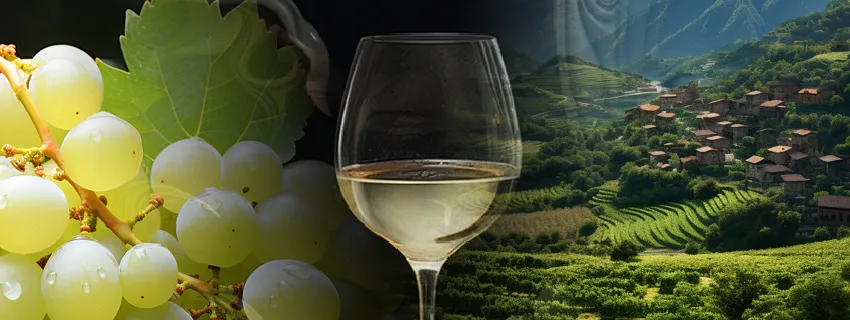Published:
Author: Antonio Maria Guerra
Prosecco Wine
HISTORY, INFO, PLACES, INTERESTING FACTS

Prosecco wine is undoubtedly one of the most famous and appreciated Italian specialties in the world. The main reasons for such a reputation are its great pleasantness and versatility: characteristics that, during the last few years, have led to a huge increase in its sales. Let’s find out its history, let’s visit the enchanting lands where its vines grow, finding out many interesting facts.

The history of Prosecco wine.
 As often happens when dealing with Italian food and wine specialties, some scholars trace the origins of Prosecco back to the period of ancient Rome. Although well-founded, it’s important to point out that this is just a hypothesis (*1), according to which the ancestor of this wine could be the ‘Pucino’, described by Pliny the Elder (*2) in his famous treatise, the ‘Naturalis historia’. At the time of the Empire, the ‘vinum Pucinum’ was regarded as a true delicacy, much appreciated by the most eminent personalities (*3), who attributed to it medicinal qualities, to the point of considering it an elixir of long life.
As often happens when dealing with Italian food and wine specialties, some scholars trace the origins of Prosecco back to the period of ancient Rome. Although well-founded, it’s important to point out that this is just a hypothesis (*1), according to which the ancestor of this wine could be the ‘Pucino’, described by Pliny the Elder (*2) in his famous treatise, the ‘Naturalis historia’. At the time of the Empire, the ‘vinum Pucinum’ was regarded as a true delicacy, much appreciated by the most eminent personalities (*3), who attributed to it medicinal qualities, to the point of considering it an elixir of long life.
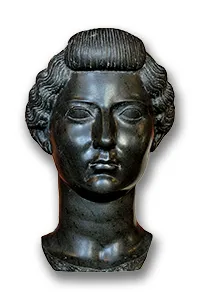 An interesting proof of the connection between Pucino and Prosecco can be found in the travel notes of an English gentleman, Fynes Moryson. In 1593 he wrote:
An interesting proof of the connection between Pucino and Prosecco can be found in the travel notes of an English gentleman, Fynes Moryson. In 1593 he wrote:
“Histria is devided into Forum Julii, and Histria, properly so called (…). Here growes the wine Pucinum, now called Prosecho, much celebrated by Pliny”
(“L’Histria è divisa tra il Forum Julii, e l’Histria propriamente detta (…). Qui cresce il vino Pucinum, ora chiamato Prosecho, assai celebrato da Plinio”)
This quote is very precious also because suggests the region in which, presumably, Prosecco started to be produced. An area where is located a place of fundamental importance in the history of this wine: the ‘Castle of Prosecco’ (*4).
It’s probably no coincidence that the fortress, dating back to the Thirteenth Century, is identified by many experts as the ancient ‘castellum nobile vino Pucinum’.
Notes:
*1: Some scholars speculate that ‘Pucino‘ may be the ancestor of ‘Ribolla Gialla’ instead of Prosecco;
*2: Pliny the Elder was a military commander, writer, naturalist philosopher and Roman governor in the 1st century AD;
*3: Including Livia Drusilla, wife of Emperor Augustus;
*4: The castle is also known as ‘Torre di Prosecco’ or ‘Castello di Moncolano’ (more information). It’s located not far from the ‘Prosecco’ district of the Municipality of Trieste.
In this article we explain the method currently used to produce Prosecco wine. To reach the page, please click this LINK.

Prosecco wine
THE MOST TRADITIONAL PRODUCERS
This article is the result of the collaboration between WebFoodCulture and the Consorzio Asolo Prosecco and the Consorzio Tutela del Vino Conegliano Valdobbiadene Prosecco DOCG, organizations gathering the most traditional producers of Prosecco wine.


Prosecco: the origins of the name.
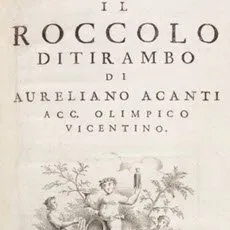 The first written evidence of the use of the word ‘Prosecco’ dates back to 1593 and can be found in the travel notebook already mentioned in the previous paragraph. Its author, Fynes Moryson, clearly mentions the ‘Prosecho’, a wine originating from the north-eastern part of the Italian peninsula. Reading these notes, it’s surprising to find out that, at the time, Prosecco was already very famous: Moryson equates it to other excellent products such as, for example, Vernaccia (‘vernazza’), Moscato (‘muscadine’) and Lacryma Christi (‘lagrima di Christo’).
The first written evidence of the use of the word ‘Prosecco’ dates back to 1593 and can be found in the travel notebook already mentioned in the previous paragraph. Its author, Fynes Moryson, clearly mentions the ‘Prosecho’, a wine originating from the north-eastern part of the Italian peninsula. Reading these notes, it’s surprising to find out that, at the time, Prosecco was already very famous: Moryson equates it to other excellent products such as, for example, Vernaccia (‘vernazza’), Moscato (‘muscadine’) and Lacryma Christi (‘lagrima di Christo’).
Another precious evidence can be found in a poem published in Venice in 1754: the ‘Roccolo Ditirambo’, written by the scholar Aureliano Acanti (*1). Here follows a very interesting quote from this work:
“… and now I would like so much to wet my mouth with the Prosecco from Monteberico, enjoying its apple bouquet. It’s the perfect Prosecco, a true example for all the others.”
“Ed or ora immolarmi voglio il becco con quel melaromatico Prosecco di Monteberico quello perfetto Prosecco eletto ci dà lo splendido nostro canonico.”
In addition to the explicit reference to ‘Prosecco’, this passage is intriguing because it indicates that in the XVIII century this wine was produced with great success on the Berici Hills (“perfetto Prosecco eletto”), near the city of Vicenza.
Notes:
*1: Anagram of the original name ‘Valeriano Acanti’.
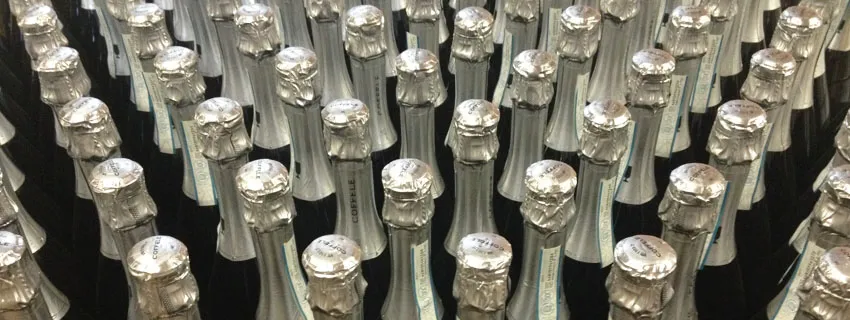
The great success of Prosecco wine.
The great international success of Prosecco began in the 1990s. Between 2013 and 2014 the number of its bottles sold on the world market surpassed those of Champagne. Not surprisingly, the most appreciated type is ‘spumante’.
Read more
Nowadays this wine is at the very center of a huge business involving hundreds of wineries and thousands of farmers, scattered in nine provinces between Veneto and Friuli-Venezia Giulia.
In addition to Italy, the reference markets for Prosecco are the United Kingdom, the United States and Germany. In this respect, it’s interesting to find out that the nation with the largest increase in sales is France.
The success of this wine should be largely attributed to its incredible quality-price ratio, something that makes very difficult to beat its achievements.

Prosecco wine in the ‘Spritz’ cocktail.
Prosecco is a very versatile wine. No wonder it’s used to prepare many types of cocktails, including the famous Italian Spritz, whose ingredients are:
- Prosecco wine;
- Aperol / Campari;
- Soda / seltz;

Prosecco DOC and Prosecco Superiore DOCG.
The DOC and DOCG labels have been adopted by the Italian State to certify the quality of the best wines produced in its territory (*1) and to protect them from imitations (*2). On 17 July 2009 the DOC ‘Prosecco’ and two DOCG, ‘Conegliano Valdobbiadene Prosecco Superiore DOCG’ (*3) and ‘Asolo Prosecco Superiore DOCG’ were established. This represented the culmination of a process lasted many years, officializing the international success of this wine.

Conegliano-Valdobbiadene DOCG
Prosecco from Conegliano-Valdobbiadene is the highest expression of this wine. Such a great quality is due to the territory in which its grapes grow: a real jewel, located between the city and Venice and the Dolomites Mountains. Thanks to the hard work of man, over the centuries the fascinating hills characterizing the landscape of this zone have been made suitable for the cultivation of vine (*4). A huge effort which has borne fruit, since in this area ‘Glera’ has found its ideal habitat (*5).
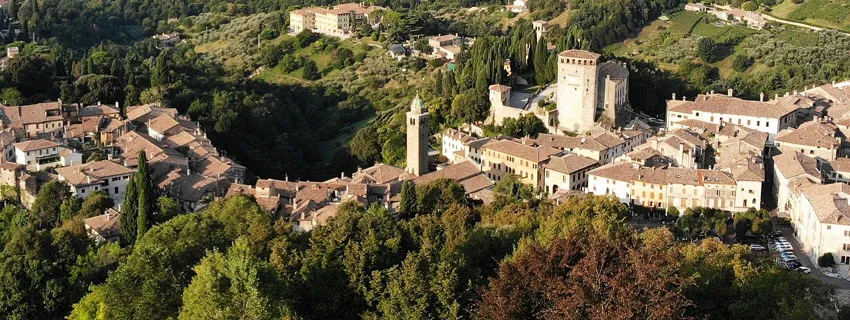
Asolo DOCG
The hills of Asolo and Montello, not far from the Dolomites, are the home of ‘Prosecco di Asolo DOCG’. These reliefs have an altitude ranging from 100 to 450 meters. The production area of the grapes includes 19 Municipalities, located around the town of Asolo. The soil of this zone provides a good amount of minerals to the plants of Glera (*5), its slope allows excess water to flow. The result is an elegant and delicate wine, characterized by a good balance between sugars and acids, a soft taste and a floral and fruity scent.
Notes:
*1: With the adoption of specific procedural guidelines (‘disciplinari di produzione’).
*2: More information about DOC and DOCG labels can be found in this article: ‘The Italian DOC and DOCG wines’.
*3: Conegliano-Valdobbiadene Prosecco got the DOC label in 1969.
*4: Thanks to the use of ‘terraces’ (‘terrazzamenti’).
*5: The vine giving life to Prosecco grapes.

Prosecco vs. Champagne.
Although many think that Italian Prosecco and French Champagne are specialties eternally competing with each other, this is absolutely not true…
Read more
… since these wines are completely different from each other, boasting very different characteristics and thus impossible to compare.
Champagne, for example, is often more complex than Prosecco, while the latter finds its greatest virtue in its ease of drinking and in the unsurpassed pleasantness.

Cartizze and Prosecco Superiore Rive, the ‘best of the best’.
If the Prosecco produced in the hills of Asolo and Conegliano-Valdobbiadene can be considered the best of this type of wine, there are two particular selections of the same wine that, in a way, are the ‘best of the best’. We are talking about ‘Cartizze’ and ‘Prosecco Superiore Rive’.
Read more
‘Prosecco Superiore Rive’:
The word ‘rive’ indicates the steepest slopes of the hills of Conegliano-Valdobbiadene: inaccessible places, where working is a heroic undertaking. Why then struggle so much to cultivate them? The answer is simple: these lands are the ideal habitat for ‘glera’. The particular nature of the soil and the precious benefits provided by the perfect altitude and exposure, help this vine to produce excellent grapes, from which an inimitable wine arises (*1). Please remember that ‘Rive’ can only be sparkling wines.
‘Cartizze’:
There is no doubt that ‘Valdobbiadene Superiore di Cartizze’ is a very special wine. Its grapes are born in an extremely small area: just over 100 hectares near the Municipality of Valdobbiadene. Difficult lands, located on the steepest slopes of the hills of Santo Stefano, Saccol and San Pietro di Barbozza, made unique by a microclimate particularly suited to the cultivation of ‘glera’ and a very special soil that, in the distant past, was part of the seabed. These factors give life to a great sparkling wine, whose quality is appreciated by many admirers all over the world.
Note:
*1: Prosecco, to be called ‘Rive’, must comply with many more regulations than a ‘normal’ Prosecco Superiore. Regulations about, for example, the grape harvest, which must be performed by hand, the production quantities and the indication of the place of origin.

“ED OR ORA IMMOLARMI VOGLIO IL BECCO CON QUEL MELAROMATICO PROSECCO (…)”
(Aureliano Acanti)

Where is Prosecco produced?
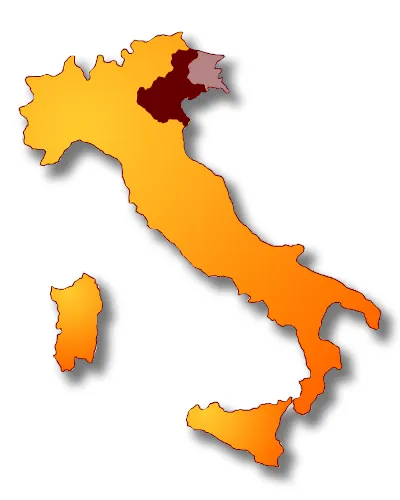 Nowadays, eighty percent of the Prosecco sold in the world is produced in the Italian region of Veneto, the remaining twenty percent in the neighboring region of Friuli-Venezia Giulia. According to the official DOC procedural guideline (*1), the grapes used for the wine must come from these territories.
Nowadays, eighty percent of the Prosecco sold in the world is produced in the Italian region of Veneto, the remaining twenty percent in the neighboring region of Friuli-Venezia Giulia. According to the official DOC procedural guideline (*1), the grapes used for the wine must come from these territories.
Over time, two particular zones stood out from the others for the excellent quality of their Prosecco, not by chance awarded with the DOCG label: we’re speaking about the beautiful hills of Asolo and Conegliano-Valdobbiadene, both in the province of Treviso.
Notes:
*1: This is the most estensive (from a territorial point of view) Italian DOC.
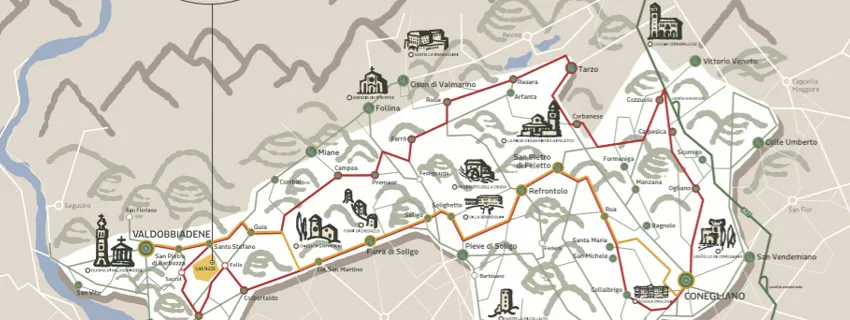
The Prosecco wine route.
The ‘Prosecco wine route’ (‘Strada del Prosecco’), the oldest Italian wine route, was instituted in 1966 and developed over time: today it’s 120 kilometers long. It consists of different itineraries crossing the hilly area around the small towns of Valdobbiadene and Conegliano, offering extremely suggestive views.
Read more
Enchanted landscapes, where the world of wine meets history and culture. The local vineyards are embellished by ancient hermitages, medieval villages, villas and castles. Even taste has its share, thanks to restaurants where it’s possible to savor the most typical specialties.
The landscapes of Prosecco Superiore DOCG.
The vines from which Prosecco Superiore DOCG is born are often part of landscapes so unique to deserve international recognition: that’s why the recent inclusion of the hills of Conegliano-Valdobbiadene in the UNESCO World Heritage List is not surprising. In this regard, it’s fair to point out that the Asolo hills are just as exquisite.

The hills of Conegliano-Valdobbiadene recognized as UNESCO World Heritage Site.
In July 2019 the 21 states that make up the Unesco Committee unanimously decided to recognize the area between the Italian municipalities of Conegliano and Valdobbiadene as World Heritage Site. It’s a territory of 97 square kilometers, in which culture and landscapes form a deep connection.
Read more
A real treasure, strongly characterized by the presence of endless rows of vines that, like a precious diadem, coronate the steep slopes of the local hills.
Not surprisingly, one of the most renowned wines in the world is born right from these rows: the Conegliano Valdobbiadene Prosecco Superiore DOCG.

‘Terraces’ for Prosecco wine.
Conegliano Valdobbiadene Prosecco Superiore DOCG owes much of its great quality to the morphology of the territory in which its grapes grow: a hilly area, often characterized by very steep slopes that, while offering well-exposed and drained soils, are very difficult to cultivate. To remedy this problem, at least partially, over the centuries the locals have modified these slopes using a particular type of terracing, known as ‘ciglione’, which stands out for the use of grassy ground instead of the classic retaining stone walls. Needless to say, this choice, in addition to making cultivation a little easier (*1), has contributed to the creation of a breathtaking landscape, unique in the world.
Notes:
*1: Cultivation that often remains so difficult to be known as ‘heroic’, considering the huge effort required of the farmers.

Consorzio Asolo Prosecco
Official website: www.asolomontello.it
Mail: info@asolomontello.it
Tel.: +39 331 5730216
Consorzio Tutela del Vino Conegliano Valdobbiadene Prosecco
Official website: www.prosecco.it
Mail: info@prosecco.it
Tel.: +39 0438 83028
Copyright information.
The images displayed in this page belong to WebFoodCulture, to Consorzio Asolo Prosecco and to Consorzio Tutela del Vino Conegliano Valdobbiadene Prosecco, with the exception of:
Public Domain Images:
- ‘Naturalis historia’, Venice Venezia, 1469 (Wikipedia Link) {PD-Art} {PD-US}
- Livia Drusilla, Fould Collection, photo by Marie-Lan Nguyen (Wikipedia Link) {PD-Art} {PD-US}
- Logo UNESCO (Wikipedia Link)
Creative Commons images:
- ‘Il Roccolo Ditirambo’, 1754, image by Sinf1226 (Wikipedia Link)

